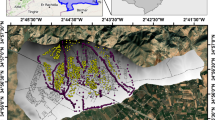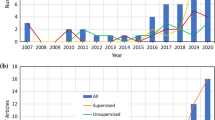Abstract
Four statistical techniques for modelling landslide susceptibility were compared: multiple logistic regression (MLR), multivariate adaptive regression splines (MARS), classification and regression trees (CART), and maximum entropy (MAXENT). According to the literature, MARS and MAXENT have never been used in landslide susceptibility modelling, and CART has been used only twice. Twenty independent variables were used as predictors, including lithology as a categorical variable. Two sets of random samples were used, for a total of 90 model replicates (with and without lithology, and with different proportions of positive and negative data). The model performance was evaluated using the area under the receiver operating characteristic curve (AUC) statistic. The main results are (a) the inclusion of lithology improves the model performance; (b) the best AUC values for single models are MLR (0.76), MARS (0.76), CART (0.77), and MAXENT (0.78); (c) a smaller amount of negative data provides better results; (d) the models with the highest prediction capability are obtained with MAXENT and CART; and (e) the combination of different models is a way to evaluate the model reliability. We further discuss some key issues in landslide modelling, including the influence of the various methods that we used, the sample size, and the random replicate procedures.








Similar content being viewed by others
References
Akgun A (2011) A comparison of landslide susceptibility maps produced by logistic regression, multi-criteria decision, and likelihood ratio methods: a case study at İzmir, Turkey. Landslides. doi:10.1007/s10346-011-0283-7
Aleotti P, Chowdhury R (1999) Landslide hazard assessment: summary review and new perspectives. Bull Eng Geol Environ 58:21–44
Araújo MB, New M (2007) Ensemble forecasting of species distributions. Trends in Ecology and Distributions 22:42–47
Ardizzone E, Cardinali M, Carrara A, Guzzetti F, Reichenbach P (2002) Impact of mapping errors on the reliability of landslide hazard maps. Nat Hazards Earth Syst Sci 2:3–14
Ayalew L, Yamagishi H (2005) The application of GIS-based logistic regression for landslide susceptibility mapping in the Kakuda–Yahiko Mountains, Central Japan. Geomorphology 65:15–31
Bonachea J, Remondo J, Díaz de Terán JR, González-Díez A, Cendrero A (2009) Landslide risk models for decision making. Risk Anal 29:1629–1643
Bonham-Carter GF (1991) Integration of scientific data using GIS. In: Maguire DJ, Goodchild MF, Rhind DW (eds) Geographical information systems: principles and applications. Longman, Ottawa, Japan
Breiman L, Friedman F, Olshen R, Stone C (1984) Classification and regression trees. Wadsworth, Belmont
Brenning A (2005) Spatial prediction models for landslide hazards: review, comparison and evaluation. Nat Hazards Earth Syst Sci 5:853–862
Carrara A (1983) Multivariate models for landslide hazard evaluation. Math Geol 15(3):403–427
Chung CJF, Fabbri AG (1999) Probabilistic prediction models for landslide hazard mapping. Photogramm Eng Rem Sens 65:1389–1399
Chung CJF, Fabbri AG (2003) Validation of spatial prediction models for landslide hazard mapping. Nat Hazards 30:451–472
Chung CF, Fabbri A, Van Westen CJ (1995) Multivariate regression analysis for landslide hazard zonation. In: Carrara A, Guzzetti F (eds) Geographical information systems in assessing natural hazards. Kluwer, Dordrecht
Colombo A, Lanteri L, Ramasco M, Troisi C (2005) Systematic GIS-based landslide inventory as the first step for effective landslide-hazard management. Landslides 2:291–301
Cruden DM, Varnes DJ (1996) Landslide types and processes. In: Turner AK, Schuster LR (eds) Landslides, investigation and mitigation. Special report 247. Transportation Research Board, Washington.
Dai FC, Lee CF (2002) Landslide characteristics and slope instability modeling using GIS, Lantau Island, Hong Kong. Geomorphology 42:213–228
Donati L, Turrini MC (2002) An objective method to rank the importance of the factors predisposing to landslides with the GIS methodology: application to an area of the Apennines (Valnerina; Perugia, Italy). Eng Geol 63:277–289
Duman TY, Can T, Gokceoglu C, Nefeslioglu HA, Sonmez H (2006) Application of logistic regression for landslide susceptibility zoning of Cekmece Area, Istanbul, Turkey. Environ Geol 51:241–256
Ercanoglu M, Gokceoglu C (2002) Assessment of landslide susceptibility for a landslide-prone area (north of Yenice, NW Turkey) by fuzzy approach. Environ Geol 41(6):720–730
Ermini L, Catani F, Casagli N (2005) Artificial neural networks applied to landslide susceptibility assessment. Geomorphology 66:327–343
Felicísimo AM, Gómez-Muñoz A (2004) GIS and predictive modelling: a comparison of methods applied to forestal management and decision-making. In: Geographical Information Systems Research UK. Proceedings of the GIS Research UK 12th Annual Conference: 143–144. Norwich, Norfolk
Fell R, Corominas J, Bonnard C, Cascini L, Leroi E, Savage WZ (2008) Guidelines for landslide susceptibility, hazard and risk zoning for land-use planning. Eng Geol 102:99–111
Fielding A, Bell JF (1997) A review of methods for the assessment of prediction errors in conservation presence/absence models. Environ Conservat 24:38–49
Friedman JH (1991) Multivariate adaptive regression splines. Ann Stat 19:1–141
Glade T, Crozier MJ (2005) A review of scale dependency in landslide hazard and risk analysis. In: Glade T, Anderson MG, Crozier MJ (eds) Landslide hazard and risk. Wiley, Chichester
Gokceoglu C, Sonmez H, Nefeslioglu HA, Duman TY, Can T (2005) The March 17, 2005 Kuzulu landslide (Sivas, Turkey) and landslide susceptibility map of its close vicinity. Eng Geol 81:65–83
Greco R, Sorriso-Valvo M, Catalano E (2007) Logistic regression analysis in the evaluation of mass movements susceptibility: the Aspromonte Case Study, Calabria, Italy. Eng Geol 89:47–66
Guisan A, Zimmermann NE (2000) Predictive habitat distribution models in ecology. Ecol Model 135:147–186
Guzzetti F, Carrara A, Cardinali M, Reichenbach P (1999) Landslide hazard evaluation: a review of current techniques and their application in a multi-scale study, Central Italy. Geomorphology 31:181–216
Guzzetti F, Reichenbach P, Ardizzone F, Cardinali M, Galli M (2006) Estimating the quality of landslide susceptibility models. Geomorphology 81:166–184
Hanley JA, McNeil BJ (1983) A method of comparing the areas under receiver operating characteristic curves derived from the same cases. Radiology 148:839–843
Hastie T, Tibshirani R, Friedman J (2001) The elements of statistical learning: data mining, inference, and prediction. Springer, New York
Hobson RD (1972) Surface roughness in topography: a quantitative approach. In: Chorley RJ (ed) Spatial analysis in geomorphology. Harper and Row, New York
Kumar L, Skidmore AK, Knowles E (1997) Modelling topographic variation in solar radiation in a GIS Environment. Int J Geogr Inform Sci 11:475–497
Lee S, Pradhan B (2007) Landslide hazard mapping at Selangor, Malaysia using frequency ratio and logistic regression models. Landslides 4:33–41
Lee S, Ryu JH, Min K, Won JS (2003) Landslide susceptibility analysis using GIS and artificial neural network. Earth Surface Processes and Landforms 28:1361–1376
Manel S, Dias JM, Ormerod SJ (1999) Comparing discriminant analysis, neural networks and logistic regression for predicting species distributions: a case study with a Himalayan river bird. Ecol Model 120:337–347
McBratney AB, Mendonca Santos ML, Minasny B (2003) On digital soil mapping. Geoderma 117:3–52
McKenzie NJ, Ryan PJ (1999) Spatial prediction of soil properties using environmental correlation. Geoderma 89:67–94
Melchiorre C, Matteucci M, Remondo J (2006) Artificial neural networks and robustness analysis in landslide susceptibility zonation. In: The 2006 IEEE International Joint Conference on Neural Network Proceedings: 4375–4381. Vancouver, Canada
Moore ID, Gessler PE, Nielsen GA, Petersen GA (1993) Terrain attributes: estimation methods and scale effects. In: Jakeman AJ, Beck MA, McAleer M (eds) Modeling change in environmental systems. Wiley, London
Muñoz J, Felicísimo AM (2004) Comparison of statistical methods commonly used in predictive modeling. J Vegetation Sci 15:285–292
Narumalani S, Jensen JR, Althausen J, Burkhalter S, Mackey HE (1997) Aquatic macrophyte modeling using GIS and logistic multiple regression. Photogramm Eng Rem Sens 63:41–49
Nefeslioglu HA, Gokceoglu C, Sonmez H (2008) An assessment on the use of logistic regression and artificial neural networks with different sampling strategies for the preparation of landslide susceptibility maps. Eng Geol 97:171–191
Nefeslioglu HA, Sezer E, Gokceoglu C, Bozkir AS, Duman TY (2010) Assessment of landslide susceptibility by decision trees in the metropolitan area of Istanbul, Turkey. Mathematical Problems in Engineering, 2010, Article ID: 901095
Neuhäuser B, Damm B, Terhorst B (2011) GIS-based assessment of landslide susceptibility on the base of the weights-of-evidence model. Landslides. doi:10.1007/s10346-011-0305-5
Ohlmacher CG, Davis CJ (2003) Using multiple regression and GIS technology to predict landslide hazard in northeast Kansas, USA. Eng Geol 69:331–343
Phillips SJ, Dudík M (2008) Modeling of species distributions with Maxent: new extensions and a comprehensive evaluation. Ecography 31:161–165
Phillips SJ, Anderson RP, Shapire RE (2006) Maximum entropy modeling of species geographic distributions. Ecol Model 190:231–259
Pradham B, Sezer EA, Gokceoglu C, Buchroithner MF (2010) Landslide susceptibility mapping by neuro-fuzzy approach in a landslide prone area (Cameron Highland, Malaysia). IEEE Trans Geosci Rem Sens 48:4164–4177
Remondo J, González-Díez A, Díaz de Terán JR, Cendrero A (2003a) Landslide susceptibility models utilizing spatial data analysis techniques. A case study from the Lower Deba Valley, Guipúzcoa (Spain). Nat Hazards 30:267–279
Remondo J, González A, Díaz de Terán JR et al (2003b) Validation of landslide susceptibility maps; examples and applications from a case study in Northern Spain. Nat Hazards 30:437–449
Remondo J, Bonachea J, Cendrero A (2005a) A statistical approach to landslide risk modelling at basin scale: from landslide susceptibility to quantitative risk assessment. Landslides 2:321–328
Remondo J, Soto J, González-Díez A et al (2005b) Human impact on geomorphic processes and hazards in mountain areas in northern Spain. Geomorphology 66:69–84
Remondo J, Bonachea J, Cendrero A (2008) Quantitative landslide risk assessment and mapping on the basis of recent occurrences. Geomorphology 94:496–507
Rossi M, Guzzetti F, Reichenbach P, Mondini AC, Peruccacci S (2010) Optimal landslide susceptibility zonation based on multiple forecasts. Geomorphology 114:129–142
Soeters R, van Westen CJ (1996) Slope instability recognition, analysis and zonation. In: Turner AK, Schuster R (eds) Landslides investigation and mitigation. Transportation research board special report, 247. National Academy Press, Washington DC
Tarboton DG (1997) A new method for the determination of flow directions and upslope areas in grid digital elevation models. Water Resour Res 33:309–319
van Asch TWJ, Malet JP, Van Beek LPH, Amitrano D (2007) Techniques, issues and advances in numerical modelling of landslide hazard. Bull Soc Géol Fr 178:65–88
van den Eeckhaut M, Reichenbach P, Guzzetti F, Rossi M, Poesen J (2009) Combined landslide inventory and susceptibility assessment based on different mapping units: an example from the Flemish Ardennes, Belgium. Nat Hazards Earth Syst Sci 9:507–521
van Westen CJ, van Asch TWJ, Soeters R (2006) Landslide hazard and risk zonation—why is it still so difficult? Bull Eng Geol Environ 65:167–184
Yeon YK, Han JG, Ryu KH (2010) Landslide susceptibility mapping in Injae, Korea, using a decision tree. Eng Geol 116:274–283
Yesilnacar E, Topal T (2005) Landslide susceptibility mapping: a comparison of logistic regression and neural networks methods in a medium scale study, Hendek region (Turkey). Eng Geol 79:251–266
Yilmaz I (2009) Landslide susceptibility mapping using frequency ratio, logistic regression, artificial neural networks and their comparison: a case study from Katlandslides (Tokat–Turkey). Comput Geosci 35:1125–1138
Zevenbergen LW, Thorne CR (1987) Quantitative analysis of land surface topography. Earth Surface Processes and Landforms 12:47–56
Author information
Authors and Affiliations
Corresponding author
Rights and permissions
About this article
Cite this article
Felicísimo, Á.M., Cuartero, A., Remondo, J. et al. Mapping landslide susceptibility with logistic regression, multiple adaptive regression splines, classification and regression trees, and maximum entropy methods: a comparative study. Landslides 10, 175–189 (2013). https://doi.org/10.1007/s10346-012-0320-1
Received:
Accepted:
Published:
Issue Date:
DOI: https://doi.org/10.1007/s10346-012-0320-1




